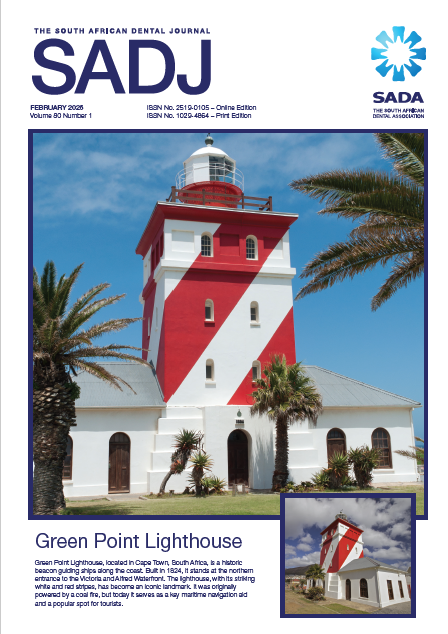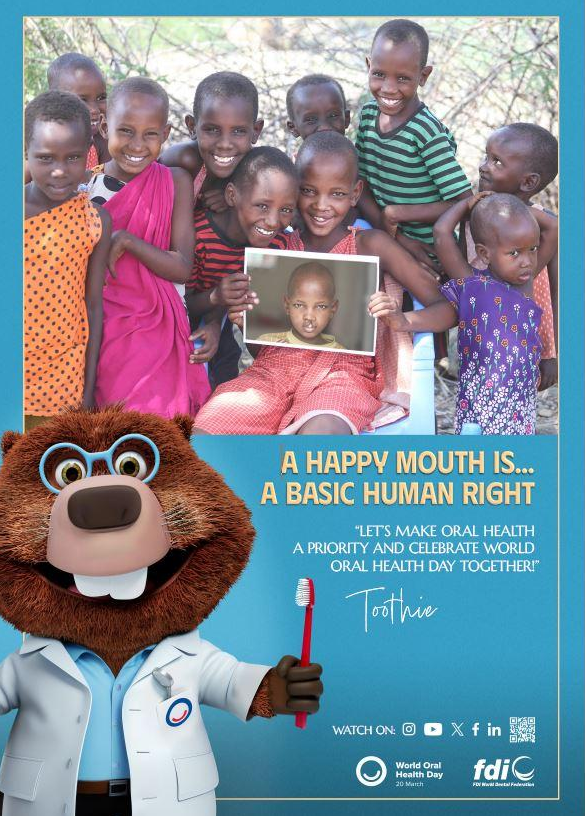Sialolithiasis and urolithiasis – coincidence or correlation? A systematic review
DOI:
https://doi.org/10.17159/sadj.v80i01.19967Keywords:
Bladder (cystolith), Gallbladder (cholelith), Bile duct (choledocholith), Organic and inorganic material, Stones, LithiasisAbstract
Lithiasis is the formation of stones within an organ, which can occur in multiple organs. Several studies have reported the possible concurrent occurrence of uroliths and sialoliths, possibly associated with shared comorbidities. This systematic review was conducted to review published research and identify the concurrent presence of uroliths and sialoliths. The review will describe diagnostic modalities, management, and prevention and suggest future research and clinical recommendations
Downloads
References
1. Busso CS, Guidry JJ, Gonzalez JJ, Zorba V, Son LS, Winsauer PJ, et al. A comprehensive analysis of sialolith proteins and the clinical implications. Clin Proteom. 2020 Mar 31;17(1). Available from: http://dx.doi.org/10.1186/s12014-020-09275-w
2. Tretiakow D, Skorek A, Ryl J, Wysocka J, Darowicki K. Ultrastructural analysis of the submandibular sialoliths: Raman spectroscopy and electron back-scatter studies. Ultrastruct Pathol. 2020 Mar 3;44(2):219-26. Available from: http://dx.doi.org/10.1080/01913123.2020.1744784
3. Kao WK, Chole RA, Ogden MA. Evidence of a microbial etiology for sialoliths. Laryngoscope. 2019 Mar 12;130(1):69-74. Available from: http://dx.doi.org/10.1002/lary.27860
4. Hemminki K, Hemminki O, Koskinen AIM, Försti A, Sundquist K, Sundquist J, et al. Familial risks in and between stone diseases: sialolithiasis, urolithiasis and cholelithiasis in the population of Sweden. BMC Nephrol. 2018 Jul 3;19(1). Available from: http://dx.doi.org/10.1186/s12882-018-0945-y
5. Lang J, Narendrula A, El-Zawahry A, Sindhwani P, Ekwenna O. Global trends in incidence and burden of urolithiasis from 1990 to 2019: An analysis of Global Burden of Disease Study data. Eur Urol Open Sci. 2022 Jan;35:37-46. Available from: http://dx.doi.org/10.1016/j.euros.2021.10.008
6. Kraaij S, Karagozoglu KH, Forouzanfar T, Veerman ECI, Brand HS. Salivary stones: Symptoms, aetiology, biochemical composition and treatment. Br Dent J. 2014 Dec;217(11):E23. Available from: http://dx.doi.org/10.1038/sj.bdj.2014.1054
7. Rakesh N, Bhoomareddy Kantharaj YD, Agarwal M, Agarwal K. Ultrastructural and elemental analysis of sialoliths and their comparison with nephroliths. J Investig Clin Dent. 2014 Feb;5(1):32-7. Available from: http://dx.doi.org/10.1111/j.2041-1626.2012.00157.x
8. Wu CC, Hung SH, Lin HC, Lee CZ, Lee HC, Chung SD. Sialolithiasis is associated with nephrolithiasis: A case-control study. Acta Otolaryngol. 2016 Jan 25;136(5):497-500. Available from: http://dx.doi.org/10.3109/00016489.2015.1129068
9. Zenk J, Constantinidis J, Kydles S, Hornung J, Iro H. Klinische und diagnostische Befunde bei der Sialolithiasis. HNO. 1999 Nov 23;47(11):963-9. Available from: http://dx.doi.org/10.1007/s001060050476
10. Kodaka T, Debari K, Sano T, Yamada M. Scanning electron microscopy and energy-dispersive X-ray microanalysis studies of several human calculi containing calcium phosphate crystals. Scanning Microsc. 1994;8(2):241-7.
11. Kraaij S, Brand H, van der Meij E, de Visscher J. Biochemical composition of salivary stones in relation to stone- and patient-related factors. Med Oral Patol Oral Cir Bucal. 2018;0-0. Available from: http://dx.doi.org/10.4317/medoral.22533
12. Harrill JA, King JS, Boyce WH. Structure and composition of salivary calculi. Laryngoscope. 1959 May;69(5):481-92. Available from: http://dx.doi.org/10.1288/00005537-195905000-00001
13. Bodner L. Giant salivary gland calculi: Diagnostic imaging and surgical management. Oral Surg Oral Med Oral Pathol Oral Radiol. 2002 Sep;94(3):320-3. Available from: http://dx.doi.org/10.1067/moe.2002.123863
14. Zenk J, Koch M, Klintworth N, König B, Konz K, Gillespie MB, et al. Sialendoscopy in the diagnosis and treatment of sialolithiasis. Otolaryngol Head Neck Surg. 2012 Jun 29;147(5):858-63. Available from: http://dx.doi.org/10.1177/0194599812452837
15. Morgan MSC, Pearle MS. Medical management of renal stones. BMJ. 2016 Mar 14;i52. Available from: http://dx.doi.org/10.1136/bmj.i52
16. Yasui T, Okada A, Hamamoto S, Ando R, Taguchi K, Tozawa K, et al. Pathophysiology-based treatment of urolithiasis. Int J Urol. 2016 Aug 18;24(1):32-8. Available from: http://dx.doi.org/10.1111/iju.13187
17. Kraaij S, Karagozoglu KH, Kenter YAG, Pijpe J, Gilijamse M, Brand HS. Systemic diseases and the risk of developing salivary stones: A case-control study. Oral Surg Oral Med Oral Pathol Oral Radiol. 2015 May;119(5):539-43. Available from: http://dx.doi.org/10.1016/j.oooo.2015.01.010
18. Choi HG, Bang W, Park B, Sim S, Tae K, Song CM. Lack of evidence that nephrolithiasis increases the risk of sialolithiasis: A longitudinal follow-up study using a national sample cohort. Gupta V, editor. PLOS ONE. 2018 Apr 26;13(4):e0196659. Available from: http://dx.doi.org/10.1371/journal.pone.0196659
19. Pak CYC. Etiology and treatment of urolithiasis. Am J Kidney Dis. 1991 Dec;18(6):624-37. Available from: http://dx.doi.org/10.1016/s0272-6386(12)80602-0
20. Hung S, Huang H, Lee H, Ching Lin H, Kao L, Wu C. A population-based study on the association between chronic periodontitis and sialolithiasis. Laryngoscope. 2016 Jan 25;126(4):847-50. Available from: http://dx.doi.org/10.1002/lary.25360
21. Koch M, Zenk J, Bozzato A, Bumm K, Iro H. Sialoscopy in cases of unclear swelling of the major salivary glands. Otolaryngol Head Neck Surg. 2005 Dec;133(6):863-8. Available from: http://dx.doi.org/10.1016/j.otohns.2005.08.005
22. Waseem BAZ, Forte V. An unusual case of bilateral submandibular sialolithiasis in a young female patient. Int J Pediatr Otorhinolaryngol. 2005 May;69(5):691-4. Available from: http://dx.doi.org/10.1016/j.ijporl.2004.11.015
23. Cook J, Lamb BW, Lettin JE, Graham SJ. The epidemiology of urolithiasis in an ethnically diverse population living in the same area. Urol J. 2016 Aug 25;13(4):2754-8. Available from: https://ojs3.sbmu.ac.ir/urolj/index.php/uj/article/view/3336
Downloads
Published
Issue
Section
License

This work is licensed under a Creative Commons Attribution-NonCommercial 4.0 International License.





.png)